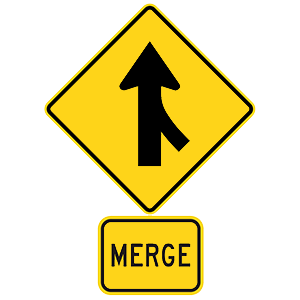2026 District Of Columbia Permit Test 11
The following questions are from real DMV written tests. These are some of the actual permit questions you will face in District Of Columbia. Each permit practice test question has three answer choices. Select one answer for each question and select "grade this section." You can find this button at the bottom of the drivers license quiz. For a complete list of questions and answers for District Of Columbia please visit https://cheat-sheets.dmv-written-test.com/en/district-of-columbia/car.
Number of Tests
Number of Question
Passing Score
9. When changing lanes, you can check your blind spot by:
Explanation
Even if your vehicle is properly equipped with mirrors, there are blind spots that cannot be seen by using the mirrors. Before changing lanes, look over your shoulder to check these areas.
10. What does this road sign mean?

Explanation
Warning signs are usually yellow with black markings. This sign warns that merging traffic will be entering from the right, so drivers should prepare to allow the incoming traffic to safely merge.
11. If you are driving on a one-way street and an emergency vehicle using its flashing lights approaches your vehicle, you must:
Explanation
If an emergency vehicle using its lights or siren approaches while you are driving on a one-way street, you must drive toward the nearest roadside and stop.
12. If your vehicle has a two-part safety belt system, you should:
Explanation
If your vehicle has a two-part seat belt system, be sure to wear both the lap belt and the shoulder belt. Wearing either part alone greatly reduces your protection. If you have an automatic shoulder belt, be sure to buckle your lap belt as well.
13. You exit the freeway on a ramp that curves downhill. You should:
Explanation
You should always slow down before entering a curve. You may not be able to see hazards ahead and braking in a curve may cause your vehicle to skid.
14. You may pass another vehicle:
Explanation
You may not pass another vehicle on a hill or in a curve because you cannot see oncoming traffic and may cause a collision. Never pass another vehicle by driving onto the shoulder of a highway. Passing another vehicle by driving over a solid yellow line is prohibited.
15. You enter a designated turn lane to make a left turn at an upcoming intersection. There is oncoming traffic. You should:
Explanation
When making a left turn, you should always begin signaling about 100 feet before the turn. You should keep your front wheels aiming straight ahead until it is safe to start your turn. This ensures that you will not be pushed into oncoming traffic if another vehicle hits you from behind.
16. If you need to slow down while driving on a slippery road, the first thing you should do is:
Explanation
To slow down on a slippery road, you should first take your foot off the gas pedal. If you need to slow down even more, gently apply a slow, steady pressure to your brake pedal.
Ranked by best match
